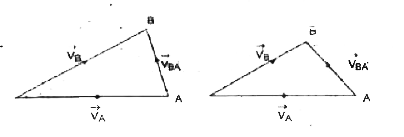A car A moves along north with velocity 30 km/h and another car B moves along east with velocity 40 km/h. The relative velocity of A with respect to B is
50 km/h North - East
50 km/h North-West
50 km/h at angle tan−1(3/4) North of West
50 km/h at angle tan−1(3/4) West of North
The correct Answer is:C
To find the relative velocity of car A with respect to car B, we can follow these steps:
Step 1: Identify the velocities of both cars
- Car A moves north with a velocity of 30 km/h.
- Car B moves east with a velocity of 40 km/h.
Step 2: Represent the velocities as vectors
- The velocity of car A can be represented as:
→VA=30^jkm/h
- The velocity of car B can be represented as:
→VB=40^ikm/h
Step 3: Calculate the relative velocity of A with respect to B
The relative velocity of A with respect to B is given by:
→VAB=→VA−→VB
Substituting the values:
→VAB=30^j−40^i
This can be rewritten as:
→VAB=−40^i+30^jkm/h
Step 4: Calculate the magnitude of the relative velocity
The magnitude of the relative velocity can be calculated using the Pythagorean theorem:
|→VAB|=√(−40)2+(30)2
Calculating this gives:
|→VAB|=√1600+900=√2500=50km/h
Step 5: Determine the direction of the relative velocity
To find the direction, we can use the tangent function:
tan(θ)=oppositeadjacent=3040=34
Thus,
θ=tan−1(34)
Step 6: State the final result
The relative velocity of car A with respect to car B is:
50km/h at an angle θ=tan−1(34) North of West
- Car A moves north with a velocity of 30 km/h.
- Car B moves east with a velocity of 40 km/h.
- The velocity of car A can be represented as:
→VA=30^jkm/h
- The velocity of car B can be represented as:
→VB=40^ikm/h
The relative velocity of A with respect to B is given by:
→VAB=→VA−→VB
Substituting the values:
→VAB=30^j−40^i
This can be rewritten as:
→VAB=−40^i+30^jkm/h
The magnitude of the relative velocity can be calculated using the Pythagorean theorem:
|→VAB|=√(−40)2+(30)2
Calculating this gives:
|→VAB|=√1600+900=√2500=50km/h
To find the direction, we can use the tangent function:
tan(θ)=oppositeadjacent=3040=34
Thus,
θ=tan−1(34)
The relative velocity of car A with respect to car B is:
50km/h at an angle θ=tan−1(34) North of West
Topper's Solved these Questions
- MOTION IN A PLANEBook:DC PANDEYChapter:MOTION IN A PLANEExercise:(B) Meical entrance special format questions (Assertion and reason)
Explore 19 Videos
- MOTION IN A PLANEBook:DC PANDEYChapter:MOTION IN A PLANEExercise:(B) Meical entrance special format questions (Mathch the columns)
Explore 6 Videos
- MOTION IN A PLANEBook:DC PANDEYChapter:MOTION IN A PLANEExercise:Check point 3.7
Explore 15 Videos
- MOTIONBook:DC PANDEYChapter:MOTIONExercise:Medical entrances gallery
Explore 19 Videos
- PROJECTILE MOTIONBook:DC PANDEYChapter:PROJECTILE MOTIONExercise:Level - 2 Subjective
Explore 10 Videos
Similar Questions
Two paarallel rail tracks run north-south Train A moves north with a speed of 54kmh−1 and train B moves south with a speed of 90kmh−1. What is the
a. relative velocity of B with respect to A?
b. relaity of a monkey running on the roof of the train A against its motion (with its velocity of 18kmh1 with respect ot the train A ) as observed by a man standing on the fround?
View SolutionA car A going north-east at 80km/h and another car B is going south-east at 60km/h. The direction of the velocity of A relative to B makes an angle with the north equal to:
View Solution
Knowledge Check
The vector difference between the absolute velocities of two bodies is called their relative velocity. The concept of relative velocity enables us to treat one body as being at rest while the other is in motion with the relative velocity. This jormalism greatly simplifies many problems. If →vAis the absolute velocity of a body A and →–––(B)that of another body B then the relative velocity of A in relation to B is →–––(AD)=→VA−→vB and →vBA=→vB-→vA.
The principle follows here is that the relative velocity of two bodies remains unchaged if the same additional velocity is imparted to both the bodies. A simple way of carrying out this operation is to be represent the velocities in magnitude and direction from a common point. Then the line joining the tips of the vectors represents the relative velocity
Q A train A moves to the east with velocity of 40 km/hr and a train B moves due north with velocity of 30 km/hr. The relative velocity of A w.rt. B is A70 km/hr towards EastB10 km/hr towards North EastC50 km/hr at some angle South of EastD50 km/hr at some angle North of East.
A70 km/hr towards EastB10 km/hr towards North EastC50 km/hr at some angle South of EastD50 km/hr at some angle North of East.A moves with 65km/h while B is coming back of A with 80km/h. The relative velocity of B with respect to A is
A80km/hB60km/hC15km/hD145km/hA body moves due East with velocity 20km/hour and then due North with velocity 15km/hour. The resultant velocity
A5km/hourB15km/hourC20km/hourD25km/hour
A bird is flying towards north with a velocity 40kmh−1 and a train is moving with velocity 40kmh−1 towards east. What is the velocity of the bird boted by a man in the train ?
View SolutionOut of the two cars A and B car A is moving towards east with velocity of 10 m/s whereas B is moving towards north with a velocity 20 m/s, then velocity of A w.r.t B is ( nearly )
View SolutionA bird is flying towards south with a velocity 40km/h and a train is moving with a velocity 40 km/h towards east. What is the velocity of the bird w.r.t. an obserber in the train ?
View SolutionA car starting from a point travels towards east with a velocity of 36kmph. Another car starting from the same point travels towards north with a velocity of 24kmph. The relative velocity of one with respect to another is
View SolutionA flag is mounted on a car moving due North with velocity of 20km/hr. Strong winds are blowing due East with velocity of 20km/hr. The flag will point in direction
View Solution
